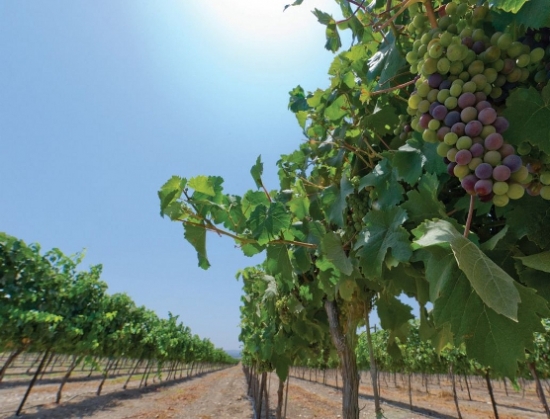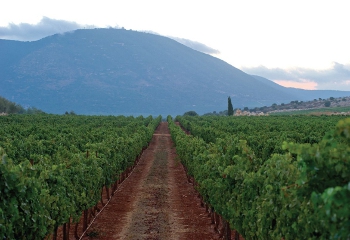
Yatir Forest vineyard up to 900 m above sea level
Often I’m asked why Israel’s wines are so much better than they were 20 or even just 10 years ago. There are lots of good answers. As restaurants got better in Israel, the demand for better wines increased as well. Additionally, there used to be only a dozen boutique wineries and now there are hundreds, mostly stressing the bottling of quality wines rather than the bulk wines which larger commercial wineries had been producing. Many of the larger commercial wineries followed suit over the last 10 years and spent millions on modernizing their equipment and focusing more and more on quality over quantity. Also, some internationally trained winemakers moved to Israel and more Israelis studied winemaking at some of the world’s best wine schools in France, Italy, the United States, Australia, Canada and New Zealand.
Yet, if I was asked to suggest one word to describe the change in quality it would be: altitude.
One of the most quoted sayings in winemaking is that “you can make bad wine from good grapes but you can’t make good wine from bad grapes.” Most of the good grapes contributing to quality wine in the world come from within a belt of 35 to 45 degrees latitude both north and south of the equator. In some regions, nearby moderating bodies of water allow vineyards to be planted further south or north of this belt (such as German vineyards in river valleys at about 50 degrees north). In other regions, the elevation of the vineyard can play a critical role on the microclimate of a vineyard and the quality of the grapes that are eventually picked.
Israeli vineyards are situated at the southern extreme in the northern hemisphere of where a prudent person might attempt to plant grapes for wine. With Israel’s vineyards situated between 29 and 33 degrees north latitude, altitude is an important key to understanding why Israel can now produce the good and great wines which it had not produced in the past. As recently as 20 years ago, most of Israel’s wine grapes were coming from lower-altitude coastal vineyards in the Judean Plains or the lower foothills of Mt Carmel that often got far too much heat and sunlight during Israel’s intense summers. This intense heat caused grapes to ripen too quickly to develop the complex flavors and aromas that winemakers and connoisseurs crave.
In 1976, however, more temperate higher-altitude vineyards were planted in the Golan Heights that would start delivering quality grapes in the 1980s for the then just starting Golan Heights Winery. Impressive results would encourage other wineries to plant, not just in the Golan Heights, but in other higher-altitude locales throughout Israel including the Upper and Lower Galilee and the Judean Hills, as well as elevated plateaus in the Negev.
So why are higher-altitude vineyards producing better wine? Another axiom asserts that “… with altitude you gain latitude.”
Viticulturists estimate that every five feet of altitude of a vineyard equates to a corresponding climate of an additional one mile of latitude so that every 100 yards would equal about 60 miles. Sixty nine (69) miles equals one degree latitude on a globe, so with many of Israel’s better vineyards located at between 400 and 1100 meters (1312 to 3600 feet) the microclimates of those vineyards at 29 to 33 degrees north latitude at these higher altitudes could mimic the microclimates of vineyards at 33 to 43 degrees latitude, which would include some of the best winemaking regions in the world. This means longer growing seasons and therefore more complex flavors and aromas, cooler nights which help preserve acidity and more developed tannins contributing to more age-worthy wines.
As one surveys the Israeli wines winning awards and international recognition, it’s not coincidental that most of their grapes are coming from these higher-elevation vineyards. The Carmel Winery, Israel’s largest, even built a facility in the Galilee alongside its Kayoumi vineyards to process grapes as soon as possible after picking. Its premium single vineyard wines sport labels extolling Kayoumi vineyards in the Galilee as well as Sha’al in the Golan Heights. Barkan, Israel’s second largest winery, sports a premium “Altitude” series of Cabernet Sauvignon, with the altitude of each vineyard in the Galilee being the brand for each wine so that there is an Altitude 412, an Altitude 624 and an Altitude 720. Barkan’s holdings also notably include vineyards 800 meters high in Mitzpe Ramon in the Negev desert. The Recanati Winery which launched in 2000 also gets most of its grapes from either higher- elevated vineyards in the Judean Hills or the Galilee including Manara, adjacent to the Lebanese border. The Tishbi Winery also has sizable holdings in Gush Etzion in the eastern Judean Hills (over 900 meters) and its highest tier red wine hails from Sde Boker in the Negev (at about 500 meters).
Most of Israel’s best boutiques also get their grapes from higher elevations, contributing to estimates that about 80% of Israel’s wine grapes now come from either the Galilee, the Golan, the Judean Hills or the Negev. As these and future higher-altitude vineyards mature, we can continue to expect to see, and better yet, to taste the benefits.
David Rhodes is a consulting sommelier and wine educator living in Raanana. You can contact him with your questions about wine at israeliwineguy@gmail.com

Kayoumi, Mount Meron, Upper Galilee 780 – 800 meters elevation

Recanati’s Manara vineyard (the altitude is) 800 meters high in the Galilee (near Lebanese border)
 ESRA Golf Competition 2012
ESRA Golf Competition 2012 Upside-Down Coffee – for another world. A Review
Upside-Down Coffee – for another world. A Review If I could tell you - a review
If I could tell you - a review-1516356428.jpg) Hand in Hand Food Pantry
Hand in Hand Food Pantry Forever Slim
Forever Slim Food Foolish
Food Foolish David Rhodes
David Rhodes